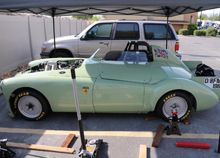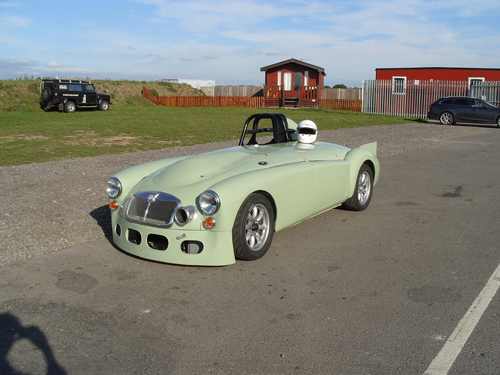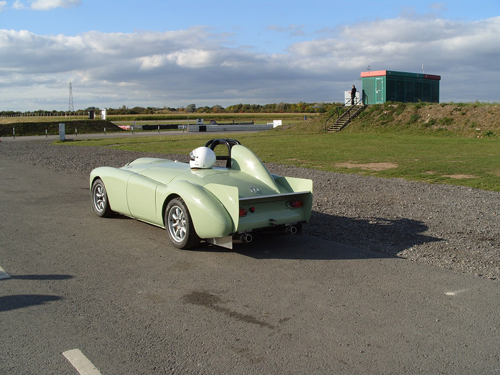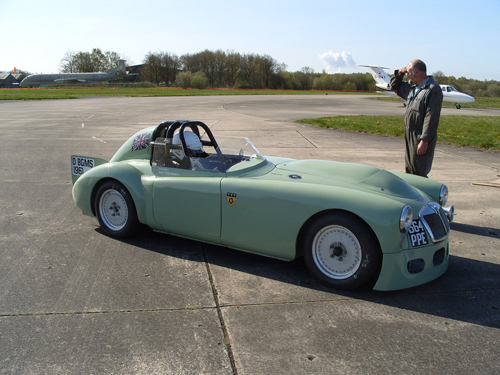MGA at 2014 Bonneville Speed Week

 A 1961 MGA roadster was entered by Walker-Chapman Performance of the UK at Bonneville. The initial target speed was 200mph.
A 1961 MGA roadster was entered by Walker-Chapman Performance of the UK at Bonneville. The initial target speed was 200mph.
Research for this article has taken many months. Our interest was piqued by a posting on the MGA Forum of the MG Experience website back in August. It showed the photo above posted by Joerg on the Jensen Owner’s Club website. Efforts to contact “Joerg” through the JOC website were foiled as comments could only be posted by Jensen members.

A search for Walker-Chapman Performance on the Internet was also unsuccessful as the company does not appear to have a website or an email address. The entry list for Bonneville Speed Week 2014 showed an entry for an MGA, with BFMS body (Modified Sports) and D engine (4.27 – 5.00 litres).
We then asked MGCC Historian and author of many books on the MGA, Piers Hubbard, if he had any knowledge of Walker-Chapman Performance. He was able to contact Colin Walker who was the project leader for the Bonneville car. The undertaking was called “Land Speed Project 664PPE”. It started with a 1961 1600 MGA, and the intention was to install a supercharged MGB engine in it.


Engine:
However, the car had a Cd (coefficient of drag) factor exceeding 0.5, and it became clear that a more powerful engine would be required to achieve 200mph.
Having seen the MG XPower SV with its 320bhp, 4.6 litre Ford Modular V8 engine, the team decided to source a 412bhp, 5.0 litre Ford Coyote V8. To this they added a Whipple 2.3 litre twin-screw supercharger, resulting in 624bhp @ 6,900rpm, and 536lb-ft of torque @ 4,700rpm. If the Cd factor could be reduced to 0.4 or better, computer modelling indicated that a top speed of around 230 mph was achievable.
Transmission:
To handle the increased power, the drive train was rebuilt. A TREMEC 6-speed gearbox was coupled to a Milner Off Road Racing CV drive shaft, and a Ford 9” axle with 12 bolt drop-out.
Suspension and Brakes:
The rear suspension was modified to use a Watts linkage, spring dampers and four trailing links. At the front, Jaguar E-Type uprights, double wishbones, and spring dampers replaced the stock set-up. Braking was uprated with discs and AP calipers all round.
Body:
Few changes to the body were required. However, the most visible modification was the raised profile bonnet to fit over the supercharger. A rear spoiler and spill plates were added, but the original shape of the body was largely retained.
An SCTA-BNI roll cage was fitted as per the regulations.

Testing:
The finished car was first tested at Blyton Park race track in England, and this indicated neutral handling through high speed bends. Subsequent high speed straight line testing took place on the 2 mile long runway at Elvington airfield in Yorkshire, England.
At this time, the deployment of the braking parachute was successfully completed. Tests with the belly pans, head cowling, and a rear spoiler fitted, indicated a Cd factor of 0.4. This was a 20% improvement on the original standard body design.
Speed Week:
The car was shipped to Los Angeles for pre-inspection in July, and then to the Bonneville Salt Flats in August. Unfortunately, heavy rain led to the postponement of Speed Week, and eventual cancellation of the event. The car is now scheduled to return to Bonneville in 2015 in the D/BFMS Class. Work on the engine at Hennessey Performance in LA has increased the power to 676bhp!
Internet Coordinators Note: We would like to thank Jack Walles, and Piers Hubbard for assistance with the research and information for this article.


